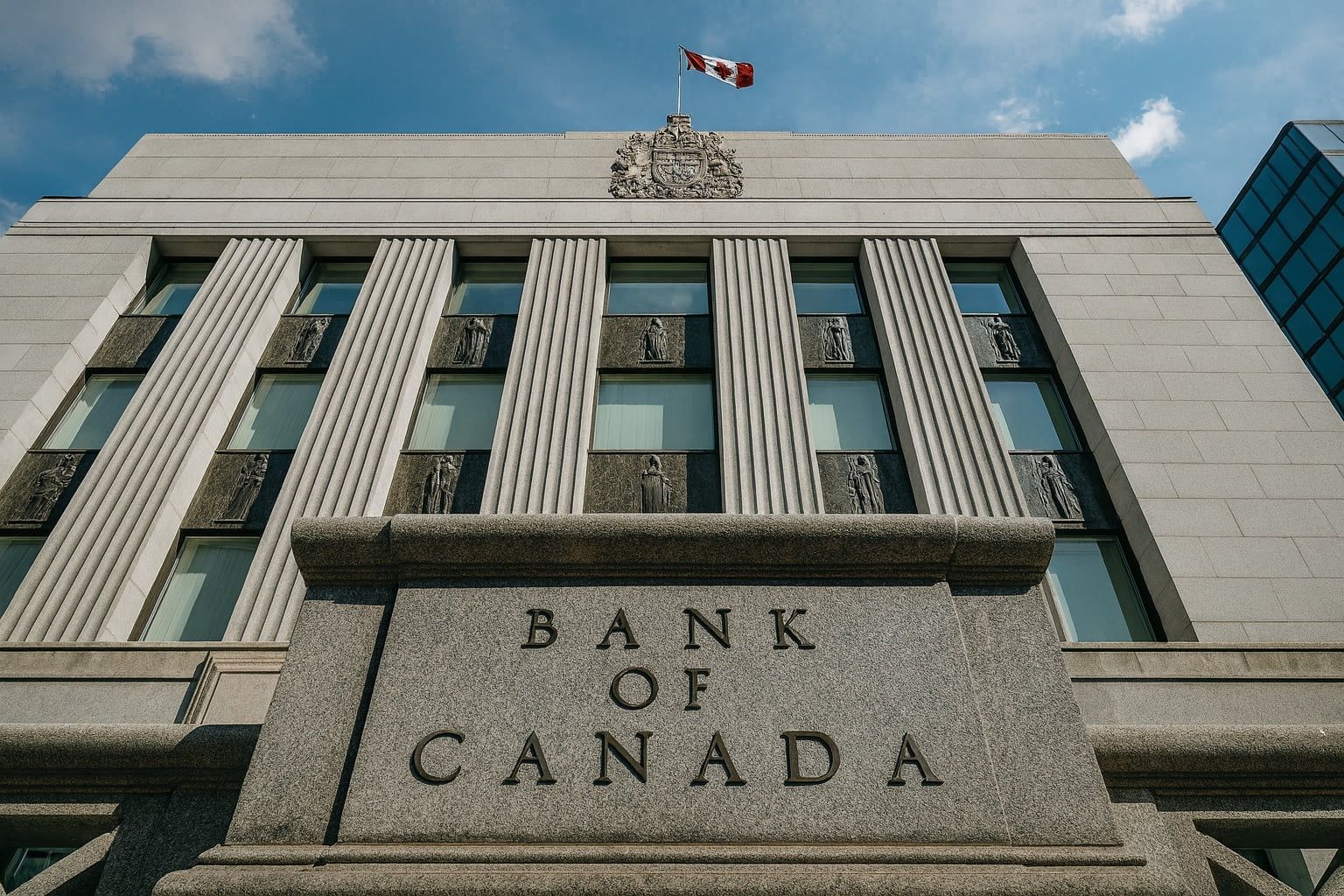The Bank of Canada (BoC) cut its overnight rate by 25 basis points to 2.25% on Oct. 29, 2025 [1], the second straight cut in as many meetings. Governor Tiff Macklem signaled this might be the last cut for now, saying policy is “about the right level to keep inflation close to 2% while helping the economy” [2]. The BoC’s new forecasts show sluggish growth (only 1.2% in 2025 and 1.1% in 2026) and inflation near 2% [3] [4]. Markets rallied: the Canadian dollar firmed to about C$1.3915 per USD [5] and the TSX Composite hovered around 30,350 points (after a strong prior close near 30,420) [6]. Major Canadian banks traded higher – for example, RBC (TSX: RY) ~C$207.8 [7] and TD (TSX: TD) ~C$115.3 [8] – as lower rates lighten borrowing costs. Even telecom giant BCE was buoyed (at ~$33.4, ~5.2% yield) [9], since analysts note a pivot to rate cuts “could boost all high-dividend stocks” [10].
With markets watching global central banks, the BoC move was broadly expected but still impactful. A Reuters poll had forecast a 25 bp cut to 2.25% [11] [12]. Macklem emphasized that the cut was to offset the hit from U.S. tariffs on steel, autos and lumber, which have caused a sharp downturn. “The weakness we’re seeing in the Canadian economy is more than a cyclical downturn. It is also a structural transition,” Macklem told reporters [13]. In other words, Canada faces ongoing trade headwinds (with a suspended US trade talks) and a cooler labour market, so more monetary support was warranted – but not too much. The central bank noted core inflation is sticky (~3% in core measures [14]) and wants to avoid overshooting its 2% target, so further easing will depend on whether forecasts play out. Indeed, Macklem added flatly: “if the outlook changes, we are prepared to respond,” but hinted no immediate move is planned [15] [16].
Analysts are divided on the outlook. Many (including Avery Shenfeld of CIBC) welcomed the cut to stimulate growth: “The priority… is still to provide some economic momentum to help close the slack and bring the unemployment rate down again,” Shenfeld said after the decision [17]. A Reuters poll of economists similarly showed a clear majority expecting the cut, but most predict the rate will hold at 2.25% for months if inflation stays near target [18] [19]. Royal Bank’s Abbey Xu warns that any further move “into outright stimulative levels of interest rates will be more difficult with inflation still sticky above target and fiscal policy potentially ramping up” [20]. Conference Board’s Pedro Antunes likewise notes “core inflation is not where the bank wants it to be and the economy has not fallen off a cliff… a rate hold will help the bank retain some future firepower” [21]. In short, the BoC seems content to pause and reassess.
Canadian markets responded positively but cautiously. The TSX Composite index was up about 0.5% on the day, brushing record levels (around 30,350) as investors cheered the dovish tilt [22]. With lower policy rates, bank stocks – typically sensitive to the yield curve – ticked higher (Royal Bank ~C$207.8, TD ~C$115.3 [23] [24]). Bell Canada’s stock (BCE) has also been volatile; TS2.Tech notes that BoC moves “will indirectly affect BCE,” and that if cuts resume in 2026 it could boost dividends across the sector [25]. The Canadian dollar strengthened (roughly 71.9 US cents [26]) and bond yields rose across the curve, reflecting markets pricing in fewer cuts ahead. Globally, U.S. indices hit fresh highs (Dow +0.6%, S&P500 +0.3%) on hopes of a Fed rate cut as well, showing investors are drawing a connection between the BoC move and worldwide easing [27] [28].
Investment analysts caution that the relief may be short-lived. Citing the “persistent trade conflicts” with the U.S., the BoC’s October Monetary Policy Report starkly cut its GDP forecasts (to ~1.2% for 2025 and 1.1% for 2026) [29]. In prepared remarks, Macklem called U.S. protectionism “a structural transition” that has “diminished Canada’s economic prospects” [30]. With no sign of tariffs ending, Warren Lovely of National Bank observed on BNN Bloomberg TV that “there’s nothing to cheer about here. We’re lowering interest rates because the economy is under immense strain…The Bank of Canada might not be done” [31]. In other words, the central bank has lowered rates, but it remains ready to act again if trade disputes or growth disappoint. TS2.Tech agrees that Ottawa’s move is in line with global easing; as one analysis noted, “Even the Bank of Canada… is expected to cut rates soon due to a weak labor market” [32], underscoring that Canadian policy is not in isolation.
Forecast: The BoC’s own projections imply a long wait before any new easing. Officials say the economy is “more than a cyclical slowdown” and that policy is now roughly neutral [33] [34]. Most economists see the overnight rate stuck at 2.25% through at least early 2026, barring big shocks. Inflation is expected to hover around the 2% target [35]. If U.S. tariffs persist or oil prices swing, the BoC could revisit rates, but for now markets expect the next move to be on hold. As TS2.Tech notes, a future pivot to cuts (perhaps in 2026 if trade fears worsen) could lift dividend-heavy sectors [36] – but any easing will wait on clear evidence Canada’s economy is on firmer footing.
Sources: Bank of Canada press releases and Monetary Policy Report (Oct 29, 2025) [37] [38]; Reuters and Bloomberg coverage of Oct.29 decision [39] [40] [41]; market data (TSX index, RBC/TD/BCE prices) [42] [43] [44]; expert commentary from analysts (Lovely, Shenfeld, Xu, Antunes) [45] [46] [47] [48]; TS2.Tech analysis [49] [50].
References
1. www.reuters.com, 2. www.canadianmortgagetrends.com, 3. www.reuters.com, 4. www.canadianmortgagetrends.com, 5. www.reuters.com, 6. www.investing.com, 7. stockanalysis.com, 8. stockanalysis.com, 9. ts2.tech, 10. ts2.tech, 11. www.reuters.com, 12. www.reuters.com, 13. www.reuters.com, 14. www.reuters.com, 15. www.reuters.com, 16. www.canadianmortgagetrends.com, 17. www.reuters.com, 18. www.reuters.com, 19. www.reuters.com, 20. www.reuters.com, 21. www.reuters.com, 22. www.investing.com, 23. stockanalysis.com, 24. stockanalysis.com, 25. ts2.tech, 26. www.reuters.com, 27. www.investing.com, 28. www.investing.com, 29. www.investing.com, 30. www.canadianmortgagetrends.com, 31. www.canadianmortgagetrends.com, 32. ts2.tech, 33. www.reuters.com, 34. www.canadianmortgagetrends.com, 35. www.reuters.com, 36. ts2.tech, 37. www.reuters.com, 38. www.canadianmortgagetrends.com, 39. www.reuters.com, 40. www.reuters.com, 41. www.canadianmortgagetrends.com, 42. stockanalysis.com, 43. stockanalysis.com, 44. ts2.tech, 45. www.canadianmortgagetrends.com, 46. www.reuters.com, 47. www.reuters.com, 48. www.reuters.com, 49. ts2.tech, 50. ts2.tech










